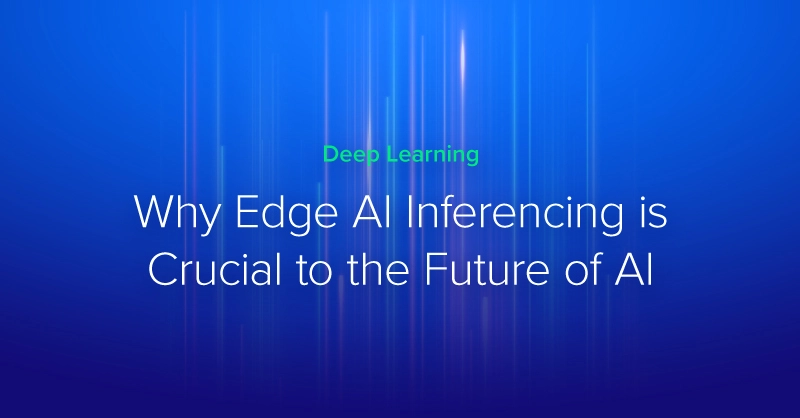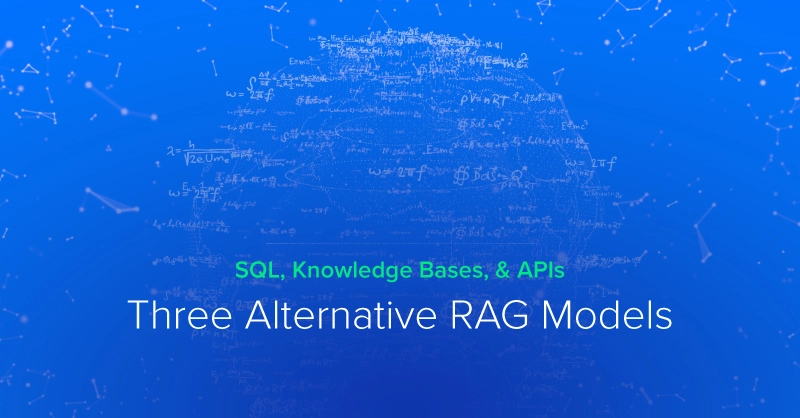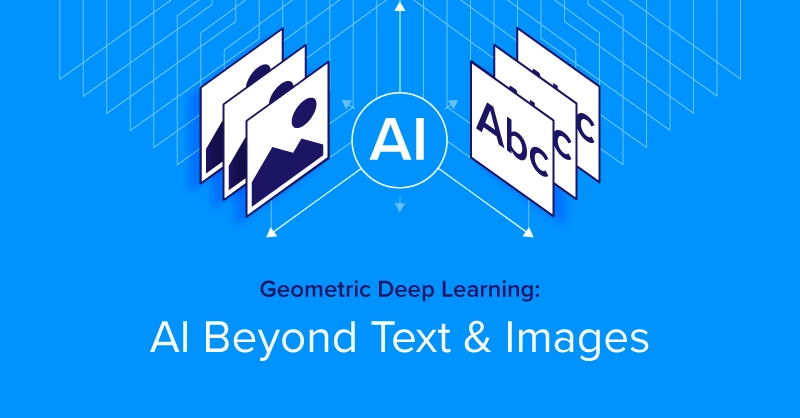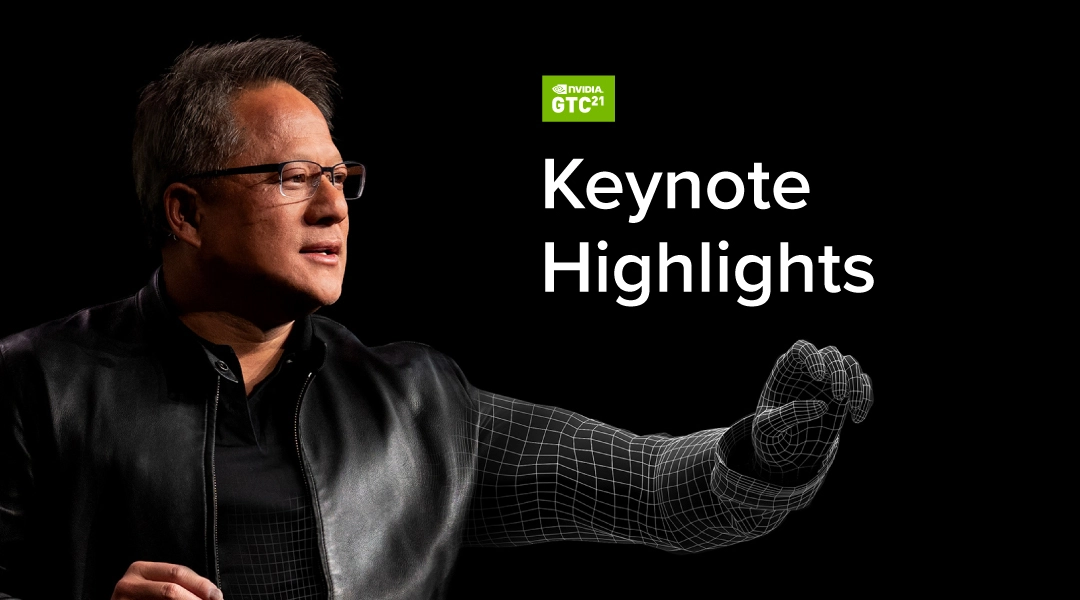
What's New from NVIDIA?
Today's NVIDIA GTC keynote with Jensen Huang once again did not disappoint. With a series of announcements during the 90 minute presentation, NVIDIA continued to show why it leads the industry and is a key driver in the role of AI in our future.
We captured some of the main highlights from the keynote below.
Keynote Highlights
- NVIDIA's Omniverse, the company's virtual world simulation and collaboration platform for 3D workflows, introduced NVIDIA Omniverse Avatar and NVIDIA Omniverse Replicator.
- NVIDIA Omniverse Avatar is a technology platform for generating interactive AI avatars, that connects the company's technologies in speech AI, computer vision, natural language understanding, recommendation engines and simulation technologies.

Avatars created in the platform are interactive characters with ray-traced 3D graphics that can see, speak, converse on a wide range of subjects, and understand naturally spoken intent. Learn more here: https://nvidianews.nvidia.com/news/nvidia-announces-platform-for-creating-ai-avatars - NVIDIA Omniverse Replicator is a powerful synthetic-data-generation engine that produces physically simulated synthetic data for training deep neural networks.
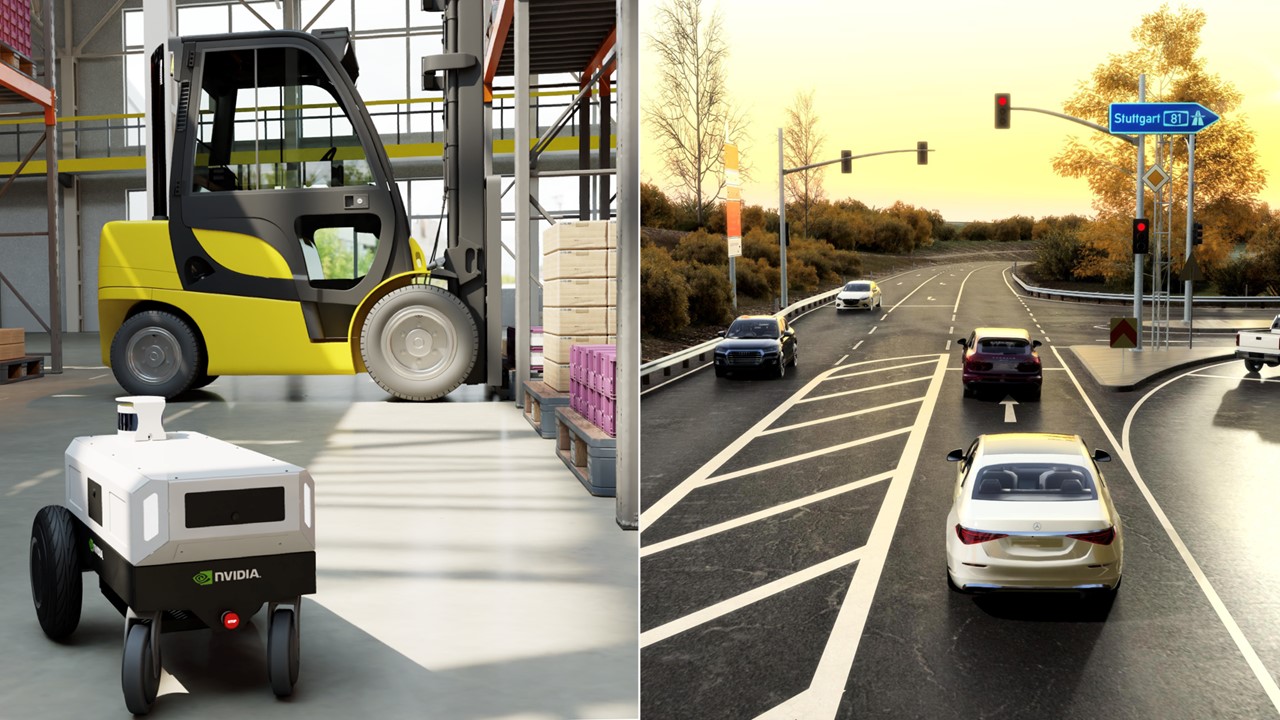
In its first implementations of the engine, the company introduced two applications for generating synthetic data: one for NVIDIA DRIVE Sim™, a virtual world for hosting the digital twin of autonomous vehicles, and another for NVIDIA Isaac Sim™, a virtual world for the digital twin of manipulation robots.
These two replicators allow developers to bootstrap AI models, fill real-world data gaps, and label the ground truth in ways humans cannot. Data generated in these virtual worlds can cover a broad range of diverse scenarios, including rare or dangerous conditions that can't regularly or safely be experienced in the real world. Learn more here:
https://nvidianews.nvidia.com/news/nvidia-announces-omniverse-replicator-synthetic-data-generation-engine-for-training-ais
Jensen Huang ended by announcing NVIDIA will build a digital twin, called E-2, or Earth Two, to simulate and predict climate change.
- NVIDIA Omniverse Avatar is a technology platform for generating interactive AI avatars, that connects the company's technologies in speech AI, computer vision, natural language understanding, recommendation engines and simulation technologies.
- NVIDIA talked about how accelerated computing has been instrumental in driving change across every industry, and how a new DPU chip (Data Processing Unit) and new AGX system will help continue driving new innovation.
- NVIDIA introduced 65 new and updated software development kits — including libraries, code samples and guides — that bring improved features and capabilities to data scientists, researchers, students and developers who are pushing the frontiers of a broad range of computing challenges. The additions include next-gen SDKs for accelerating quantum computing, last-mile delivery algorithms and graph neural network mining. Some new SDKs include:
- NVIDIA ReOpt, for real-time logistics, introduces advanced, massively parallel algorithms that optimize vehicle routes, warehouse selection and fleet mix. Its dynamic rerouting capabilities can reduce travel time, save fuel costs and minimize idle periods, potentially saving billions for the logistics and supply chain industries.
- cuNumeric, for array computing, implements the NumPy application programming interface for automatic scaling to multi-GPU and multi-node systems with zero code changes — a value for the 20 million-strong community of data scientists, researchers and scientists using Python. Available now on GitHub and Conda, it scales to thousands of GPUs, creating accelerated computing for the PyData and NumPy ecosystem.
- cuQuantum, for quantum computing, enables large quantum circuits to be simulated dramatically faster, allowing quantum researchers to study a broader space of algorithms and applications. Developers can simulate areas such as near-term variational quantum algorithms for molecules and error correction algorithms to identify fault tolerance, as well as accelerate popular quantum simulators from Atos, Google and IBM.
- CUDA-X accelerated DGL container, for graph neural networks, offers developers and data scientists working on GNNs with large graphs a quick way to set up a working environment. The container makes it easy to work in an integrated, GPU-accelerated GNN environment combining DGL and PyTorch. With GPU-accelerated GNNs, even the largest graphs in the world, approaching a trillion edges in a single graph, can be mined for insights. For instance, Pinterest uses graph neural networks with billions of nodes and edges to understand their ecosystem of over 300 billion Pins, based on GPUs and optimized libraries for training and inference of models.
- NVIDIA announced the global expansion of its NVIDIA LaunchPad program, which is growing from its initial availability in North America to operations in nine locations around the world.
LaunchPad allows for quick testing and prototyping of AI workflows with cloud-based interfaces into private compute, storage and network infrastructure. It includes development tools like TensorFlow and PyTorch, as well as application frameworks focused on vision AI, medical imaging, cybersecurity and more.
NVIDIA Base Command coordinates AI development, running workloads across powerful accelerated computing infrastructure wherever data resides. NVIDIA Fleet Command securely deploys, manages and scales AI on NVIDIA-Certified servers in the data center or at the network edge, enabling enterprises to control their AI deployments from a single screen.
LaunchPad also features the NVIDIA AI Enterprise software suite running on NVIDIA-Certified Systems to power enterprise AI workloads in VMware vSphere environments. - The company also announced the NVIDIA Isaac robotics platform can now be easily integrated into the Robot Operating System, or ROS, a widely-used set of software libraries and tools for robot applications.
- The company unveiled the NVIDIA NeMo Megatron framework for training language models with trillions of parameters, the Megatron 530B customizable LLM that can be trained for new domains and languages, and NVIDIA Triton Inference Server™ with multi-GPU, multinode distributed inference functionality.
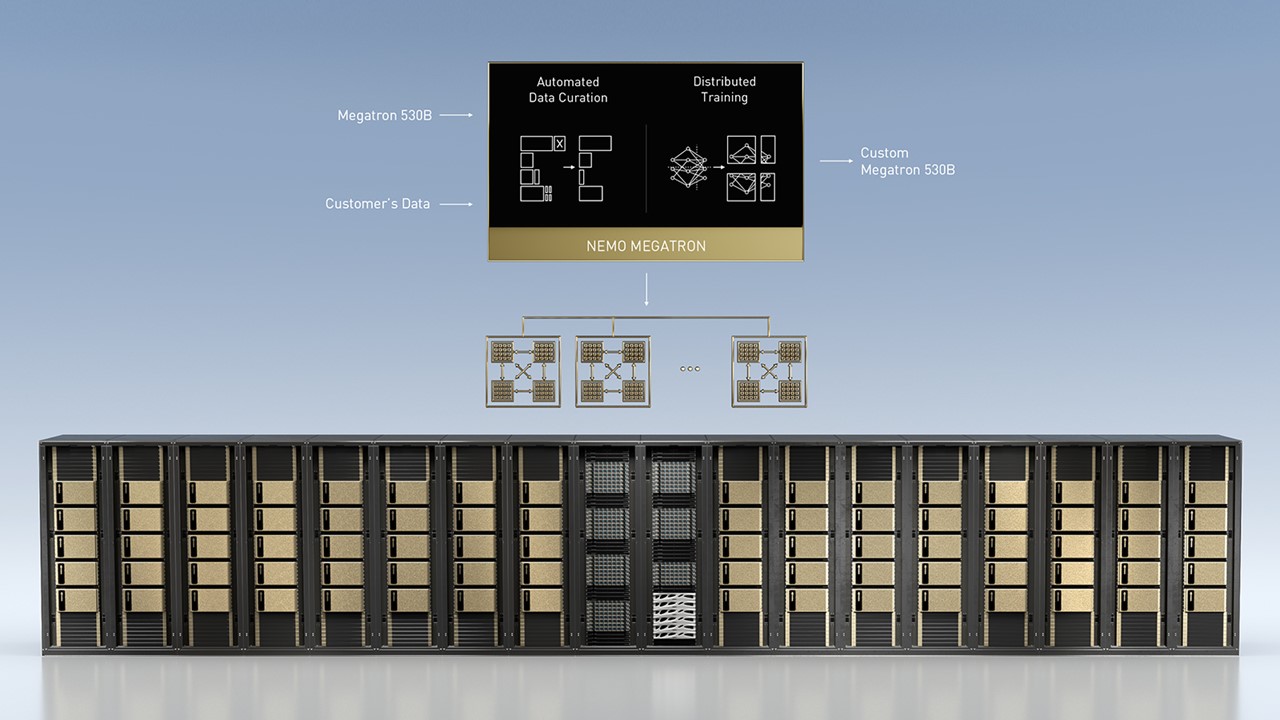
Combined with NVIDIA DGX™ systems, these tools provide a production-ready, enterprise-grade solution to simplify the development and deployment of large language models. - NVIDIA announced NVIDIA Quantum-2, the next generation of its InfiniBand networking platform, which offers the extreme performance, broad accessibility and strong security needed by cloud computing providers and supercomputing centers.
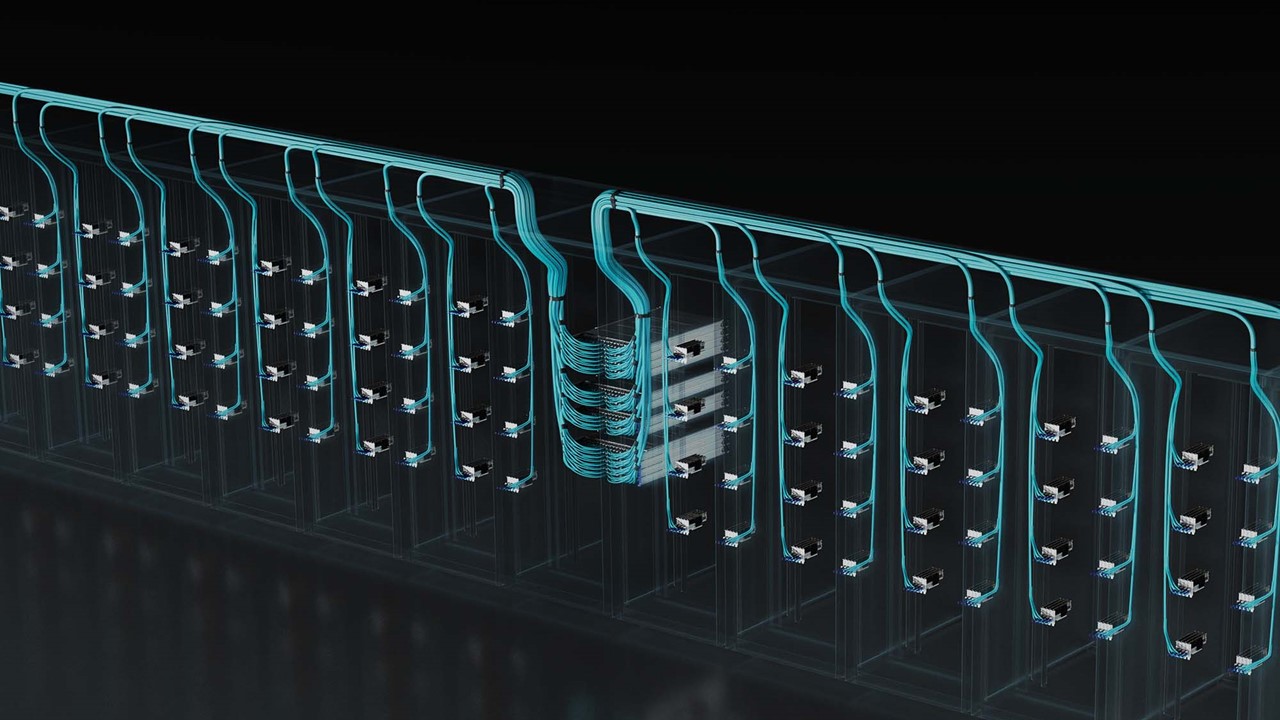
The most advanced end-to-end networking platform ever built, NVIDIA Quantum-2 is a 400Gbps InfiniBand networking platform that consists of the NVIDIA Quantum-2 switch, the ConnectX-7® network adapter, the BlueField-3® data processing unit (DPU) and all the software that supports the new architecture.
The introduction of NVIDIA Quantum-2 comes as supercomputing centers are increasingly opening to multitudes of users, many from outside their organizations. At the same time, the world’s cloud service providers are beginning to offer more supercomputing services to their millions of customers.
NVIDIA Quantum-2 includes key features required for demanding workloads running in either arena. Supercharged by cloud-native technologies, it provides high performance with 400 gigabits per second of throughput and advanced multi-tenancy to accommodate many users.
Click here to watch every announcement during the full NVIDIA keynote for GTC 2021.
Have questions about how to get started with NVIDIA, or upgrading your current infrastructure?
Contact Exxact today

NVIDIA GTC Keynote Highlights
What's New from NVIDIA?
Today's NVIDIA GTC keynote with Jensen Huang once again did not disappoint. With a series of announcements during the 90 minute presentation, NVIDIA continued to show why it leads the industry and is a key driver in the role of AI in our future.
We captured some of the main highlights from the keynote below.
Keynote Highlights
- NVIDIA's Omniverse, the company's virtual world simulation and collaboration platform for 3D workflows, introduced NVIDIA Omniverse Avatar and NVIDIA Omniverse Replicator.
- NVIDIA Omniverse Avatar is a technology platform for generating interactive AI avatars, that connects the company's technologies in speech AI, computer vision, natural language understanding, recommendation engines and simulation technologies.

Avatars created in the platform are interactive characters with ray-traced 3D graphics that can see, speak, converse on a wide range of subjects, and understand naturally spoken intent. Learn more here: https://nvidianews.nvidia.com/news/nvidia-announces-platform-for-creating-ai-avatars - NVIDIA Omniverse Replicator is a powerful synthetic-data-generation engine that produces physically simulated synthetic data for training deep neural networks.

In its first implementations of the engine, the company introduced two applications for generating synthetic data: one for NVIDIA DRIVE Sim™, a virtual world for hosting the digital twin of autonomous vehicles, and another for NVIDIA Isaac Sim™, a virtual world for the digital twin of manipulation robots.
These two replicators allow developers to bootstrap AI models, fill real-world data gaps, and label the ground truth in ways humans cannot. Data generated in these virtual worlds can cover a broad range of diverse scenarios, including rare or dangerous conditions that can't regularly or safely be experienced in the real world. Learn more here:
https://nvidianews.nvidia.com/news/nvidia-announces-omniverse-replicator-synthetic-data-generation-engine-for-training-ais
Jensen Huang ended by announcing NVIDIA will build a digital twin, called E-2, or Earth Two, to simulate and predict climate change.
- NVIDIA Omniverse Avatar is a technology platform for generating interactive AI avatars, that connects the company's technologies in speech AI, computer vision, natural language understanding, recommendation engines and simulation technologies.
- NVIDIA talked about how accelerated computing has been instrumental in driving change across every industry, and how a new DPU chip (Data Processing Unit) and new AGX system will help continue driving new innovation.
- NVIDIA introduced 65 new and updated software development kits — including libraries, code samples and guides — that bring improved features and capabilities to data scientists, researchers, students and developers who are pushing the frontiers of a broad range of computing challenges. The additions include next-gen SDKs for accelerating quantum computing, last-mile delivery algorithms and graph neural network mining. Some new SDKs include:
- NVIDIA ReOpt, for real-time logistics, introduces advanced, massively parallel algorithms that optimize vehicle routes, warehouse selection and fleet mix. Its dynamic rerouting capabilities can reduce travel time, save fuel costs and minimize idle periods, potentially saving billions for the logistics and supply chain industries.
- cuNumeric, for array computing, implements the NumPy application programming interface for automatic scaling to multi-GPU and multi-node systems with zero code changes — a value for the 20 million-strong community of data scientists, researchers and scientists using Python. Available now on GitHub and Conda, it scales to thousands of GPUs, creating accelerated computing for the PyData and NumPy ecosystem.
- cuQuantum, for quantum computing, enables large quantum circuits to be simulated dramatically faster, allowing quantum researchers to study a broader space of algorithms and applications. Developers can simulate areas such as near-term variational quantum algorithms for molecules and error correction algorithms to identify fault tolerance, as well as accelerate popular quantum simulators from Atos, Google and IBM.
- CUDA-X accelerated DGL container, for graph neural networks, offers developers and data scientists working on GNNs with large graphs a quick way to set up a working environment. The container makes it easy to work in an integrated, GPU-accelerated GNN environment combining DGL and PyTorch. With GPU-accelerated GNNs, even the largest graphs in the world, approaching a trillion edges in a single graph, can be mined for insights. For instance, Pinterest uses graph neural networks with billions of nodes and edges to understand their ecosystem of over 300 billion Pins, based on GPUs and optimized libraries for training and inference of models.
- NVIDIA announced the global expansion of its NVIDIA LaunchPad program, which is growing from its initial availability in North America to operations in nine locations around the world.
LaunchPad allows for quick testing and prototyping of AI workflows with cloud-based interfaces into private compute, storage and network infrastructure. It includes development tools like TensorFlow and PyTorch, as well as application frameworks focused on vision AI, medical imaging, cybersecurity and more.
NVIDIA Base Command coordinates AI development, running workloads across powerful accelerated computing infrastructure wherever data resides. NVIDIA Fleet Command securely deploys, manages and scales AI on NVIDIA-Certified servers in the data center or at the network edge, enabling enterprises to control their AI deployments from a single screen.
LaunchPad also features the NVIDIA AI Enterprise software suite running on NVIDIA-Certified Systems to power enterprise AI workloads in VMware vSphere environments. - The company also announced the NVIDIA Isaac robotics platform can now be easily integrated into the Robot Operating System, or ROS, a widely-used set of software libraries and tools for robot applications.
- The company unveiled the NVIDIA NeMo Megatron framework for training language models with trillions of parameters, the Megatron 530B customizable LLM that can be trained for new domains and languages, and NVIDIA Triton Inference Server™ with multi-GPU, multinode distributed inference functionality.

Combined with NVIDIA DGX™ systems, these tools provide a production-ready, enterprise-grade solution to simplify the development and deployment of large language models. - NVIDIA announced NVIDIA Quantum-2, the next generation of its InfiniBand networking platform, which offers the extreme performance, broad accessibility and strong security needed by cloud computing providers and supercomputing centers.

The most advanced end-to-end networking platform ever built, NVIDIA Quantum-2 is a 400Gbps InfiniBand networking platform that consists of the NVIDIA Quantum-2 switch, the ConnectX-7® network adapter, the BlueField-3® data processing unit (DPU) and all the software that supports the new architecture.
The introduction of NVIDIA Quantum-2 comes as supercomputing centers are increasingly opening to multitudes of users, many from outside their organizations. At the same time, the world’s cloud service providers are beginning to offer more supercomputing services to their millions of customers.
NVIDIA Quantum-2 includes key features required for demanding workloads running in either arena. Supercharged by cloud-native technologies, it provides high performance with 400 gigabits per second of throughput and advanced multi-tenancy to accommodate many users.
Click here to watch every announcement during the full NVIDIA keynote for GTC 2021.
Have questions about how to get started with NVIDIA, or upgrading your current infrastructure?
Contact Exxact today

